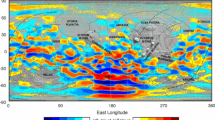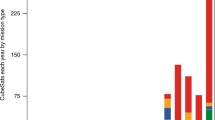Abstract
The FAST satellite is a highly sophisticated scientific satellite designed to carry out in situ measurements of acceleration physics and related plasma processes associated with the Earth's aurora. Initiated and conceptualized by scientists at the University of California at Berkeley, this satellite is the second of NASA's Small Explorer Satellite program designed to carry out small, highly focused, scientific investigations. FAST was launched on August 21, 1996 into a high inclination (83°) elliptical orbit with apogee and perigee altitudes of 4175 km and 350 km, respectively. The spacecraft design was tailored to take high-resolution data samples (or `snapshots') only while it crosses the auroral zones, which are latitudinally narrow sectors that encircle the polar regions of the Earth. The scientific instruments include energetic electron and ion electrostatic analyzers, an energetic ion instrument that distinguishes ion mass, and vector DC and wave electric and magnetic field instruments. A state-of-the-art flight computer (or instrument data processing unit) includes programmable processors that trigger the burst data collection when interesting physical phenomena are encountered and stores these data in a 1 Gbit solid-state memory for telemetry to the Earth at later times. The spacecraft incorporates a light, efficient, and highly innovative design, which blends proven sub-system concepts with the overall scientific instrument and mission requirements. The result is a new breed of space physics mission that gathers unprecedented fields and particles observations that are continuous and uninterrupted by spin effects. In this and other ways, the FAST mission represents a dramatic advance over previous auroral satellites. This paper describes the overall FAST mission, including a discussion of the spacecraft design parameters and philosophy, the FAST orbit, instrument and data acquisition systems, and mission operations.
Similar content being viewed by others
References
Baker, D. N., Chin, G., and Pfaff, R. F.: 1991, ‘NASA's Small Explorer Program', Physics Today, 44, 44.
Carlson, C. W., Pfaff, R. F., and Watzin, J. G.: 1998, ‘The Fast Auroral SnapshoT (FAST) mission', Geophys. Res. Lett. 25, 2013.
Carlson, C. W., McFadden, J. P., Turin, P., Curtis, D. W., and Magoncelli, T.: 2001, ‘The Electron and Ion Plasma Experiment for FAST', Space Sci. Rev., (this issue).
Elphic, R. C., Means, J. D., Snare, R. C., Strangeway, R. J., Kepko, L., and Ergun, R. E.: 2001, ‘Magnetic Field Instruments for the FAST Auroral Snapshot Explorer', Space Science Reviews, (this issue).
Ergun, R. E., Carlson, C. W., Mozer, F. S., Delory, G. T., Temerin, M., McFadden, J. P., Pankow, D., Abiad, R., Harvey, P., Wilkes, R., Primbsch, H., Elphic, R., Strangeway, R., Pfaff, R., and Cattell, C. A.: 2001, ‘The FAST Satellite Fields Instrument', Space Sci. Rev., (this issue).
Harvey, P. R., Curtis, D. W., Heetderks, H. D., Pankow, D., Rauch-Leiba, J. M., Wittenbrock, S. K., and McFadden, J. P.: 2001, ‘The FAST Spacecraft Instrument Data Processing Unit', Space Sci. Rev., (this issue).
Klumpar, D. M., Möbius, E., Kistler, L. M., Popecki, M., Hertzberg, E., Crocker, K., Granoff, M., Tang, Li, Carlson, C. W., McFadden, J., Klecker, B., Eberl, F., Künneth, E., Kästle, H., Ertl, M., Peterson, W. K., Shelley, E. G., and Hovestadt, D.: 2001, ‘The Time-of-Flight Energy, Angle, Mass Spectrograph (TEAMS) Experiment for FAST', Space Sci. Rev., (this issue).
Kruer, M. and Lyons, J.: 1994, ‘The FAST Solar Array: Challenging Requirements, Novel Design', Proceedings of the First World Conference on Photovoltaic Energy Conversion, IEEE.
McFadden, J. P, Carlson, C.W., and Ergun, R. E.: 1999, ‘Microstructure of the Auroral Acceleration Region as Observed by FAST', J. of Geophys. Res. 104, 14453.
McFadden, J. P., Egun, R. E., Carlson, C. W., Herrick, W., Loran, J., Vernetti, J., Teitler, W., Bromund, K., and Quinn, T.: 1999, ‘Science Operations and Data Handling for the FAST Satellite', Space Sci. Rev., (this issue).
Mende, S. B., Heetderks, H., Frey, H. V., Lampton, M., Geller, S. P., Habraken, S., Renotte, E., Jamar, C., Rochus, P., Spann, J., Fuselier, S. A., Gerard, J.-C., Gladstone, G. R., Murphree, S., and Cogger, L.: 2000, ‘Far Ultraviolet Imaging from the IMAGE spacecraft: 1. System Design', Space Sci. Rev., 91, 243.
Pankow, D., Besuner, R., Ullrich, R., and Wilkes, R.: 2001, ‘Deployment Mechanisms on the FAST Satellite: Magnetometer, Radial Wire, &' Axial Booms', Space Sci. Rev., (this issue).
Parrish, Keith: 1999, ‘On-Orbit Thermal Performance and Model Correlation of the Fast Auroral Snapshot Explorer', Proceedings International Conference on Environmental Systems, AES.
Schnurr, R., Everett, D., Gruner, T., Quinn, T., Chiville, M.: 1995, ‘FAST MUE Power System Electronics: An Approach to a Magnetically Clean and Modular Design’, Supplemental Proceedings of the 9th Annual AIA/USU Conference on Small Satellites, Logan, Utah, September 18–21.
Author information
Authors and Affiliations
Rights and permissions
About this article
Cite this article
Pfaff, R., Carlson, C., Watzin, J. et al. An Overview of the Fast Auroral SnapshoT (FAST) Satellite. Space Science Reviews 98, 1–32 (2001). https://doi.org/10.1023/A:1013187826070
Issue Date:
DOI: https://doi.org/10.1023/A:1013187826070




